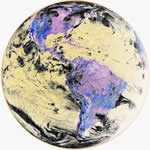Seven Sacred Springs:
Explorations around Assagao
By Chinmaya Dunster

Early in 2013, I was living in the little village of Assagao in North Goa, India, when I chanced on a little privately-printed booklet about the village. I was immediately intrigued to read of "seven mineral-rich hill springs with healing properties, now abandoned and forgotten." As the hot season began to intensify and with the vision of finding cool spring water, I set out to try to find them.
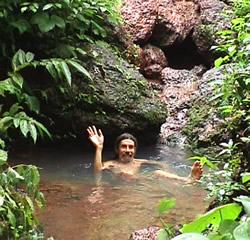 Bairo Alto Spring
Bairo Alto Spring Photo: Chinmaya Dunster
Assagao is set in a valley just five kilometers long and two wide, split down the middle by the Vau, a central stream bordered by ricefields and coconut groves, and enclosed by low hills of red laterite rock covered in jungle and cashew plantations. There are two seasons: eight rainless months, getting hotter and more humid as the year progresses; and monsoon, when the area receives over three meters of rain between June and September. Up until the development of the tourism industry over the past generation (which has provided new sources of income on the nearby coastal strip, and in the village itself by the selling off or renting out of houses and building land to outsiders) the villagers were traditionally completely dependant on farming for their livelihoods. As my explorations were to reveal, the abandonment of the traditional springs has been part of a general shift away from agriculture, evidenced by disused fields, overgrown plantations, crumbling walls and collapsed irrigation ditches, all quickly returning to a state of impenetrable jungle. Pretty ironic in a country with hundreds of millions of poor inhabitants, desperate for land to feed themselves!
This part of Goa was ruled by the Portugese for 450 years and was thoroughly "Christianized" by these fanatical invaders, its ancient Hindu temples and sacred trees destroyed, its inhabitants forced to chose between exile or convertion. Today, Assagao’s population of around 3,500 is split evenly between Christians and Hindus, with the Hindus having returned here only during the past half century since the Portugese left. This is significant because another of my discoveries shows how, despite a Christian veneer-- the churches, chapels and wayside crosses-- original customs and beliefs with a deep respect for natural phenomena must have survived the centuries of persecution.
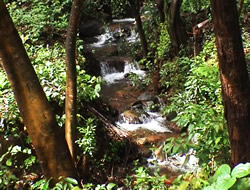 The Vau
The VauPhoto: Chinmaya Dunster
The terrain around Assagao is not difficult, distances are small, and aside from the need to be alert for snakes and the thorny nature of many jungle plants, exploring here is hardly demanding. But there are no detailed maps available in India (the powers-that-be consider making these available to the general public a security risk) and finding anywhere in India therefore comes down to asking around and following one’s nose.
I decided to begin with the Valle, the source of the Vau that ran right past my house, described in the booklet as an "age old perennial spring good for lung problems and rheumatism." Following the stream, with its lining of crumbling laterite blocks, up into the hills from my home might therefore seem the obvious way to find the place. But, as I quickly found out, this involved swamps, muddy rice fields and disused paths blocked by scrub and newly-built walled compounds. So, after poring over Google Earth, tracing the line of darker green that indicates the thick forest and coconut groves marking out the Vau’s course, I headed off on a minor road leading up towards higher ground. This soon melted away into overgrown cashew orchards and regenerating jungle. Beside a decaying chapel, a local man pointed vaguely towards the green hills. "Oh yes," he told me, "there used to be a path to the Valle from here, but for years the cashew harvesters have no longer come to clear the paths. You can’t get through now."
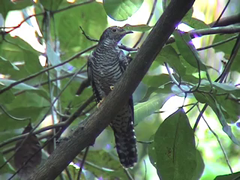 Koyal in cashew tree
Koyal in cashew treePhoto: Chinmaya Dunster
I tried a second road which dwindled into a labyrinth of tracks, all bristling with thorny bushes and hidden beneath fallen leaves, each ending in impenetrable thickets. Spider webs laced the spaces between old mango and palm trees, and overhead a cacophany of birds called out their displeasure at my clumsy intrusion. I found myself beating about the bush for an hour before I reached the dry streambed. Coming on some ruined walls, and finally hearing the tinkle of flowing water, I felt a sudden sense of dislocation from the world outside; I had found the first spring... and I entered the Valle.
The place possesses an astonishing serenity: a thin trickle of clear water seeps out of the earth between maidenhair ferns, its flow gathering strength and tumbling over multicoloured strata; the forest trees seem to congregate around the spot, soaring upwards to create a wide bowl of clear space beneath interlacing branches high overhead. A few meters from the source someone had channeled the springwater into a slim cascade with a short piece of hosepipe and I was able to shower off the sweat of my exertions.
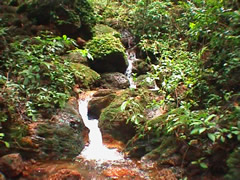 The Valle
The VallePhoto: Chinmaya Dunster
It became a place of contemplation for me on many visits there over the ensuing months: musing over the fallen blocks of rough-hewn laterite, which give the impression of having been strewn about by mighty forces, and which are clearly the remains of a complex water management system; enjoying the company of a towering banyan tree, its roots embracing giant boulders, that presides over the spring from a vantage point a little higher up the watercourse; and picking up garbage. One afternoon a family came down a precipitous path from the slummy housing colony on the hill above to do their laundry under the hosepipe. They must come regularly because every time I went, there were always their soap wrappers and odd bits of abandoned clothing for me to clean up. There was also a torrent of household garbage that the monsoon rains wash down the streambed above the spring from the road on the hilltop, which is used (like so many of Goa’s roads) as a rubbish dump. The Valle is a paradise –and it seems not totally forgotten - but a tarnished one.
Did you like the article? Subscribe here to our New Article Email Alert or RSS feeds.
Sharing is caring! Don't forget to share the love, and keep the conversation going by leaving a comment below:
Advertisement
